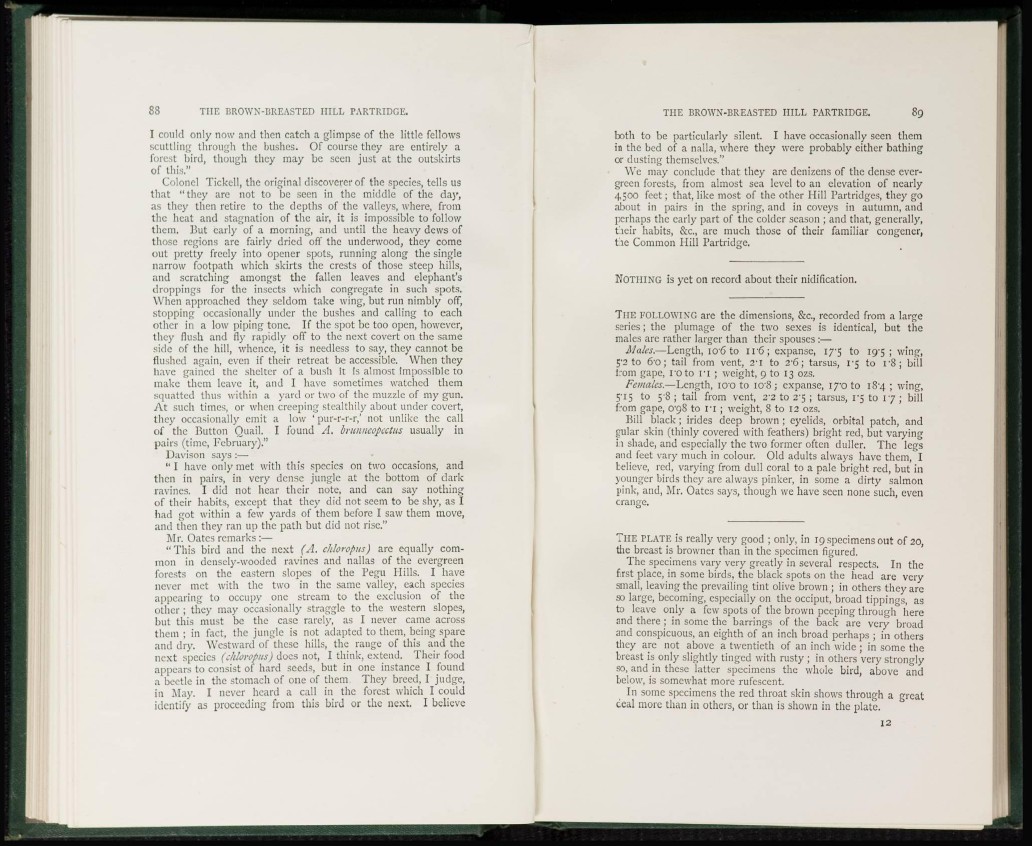
88 THE BROWN-BREASTED HILL PARTRIDGE.
I could only now and then catch a glimpse of the little fellows
scuttling through the bushes. Of course they are entirely a
forest bird, though they may be seen just at the outskirts
of this."
Colonel Tickell, the original discoverer of the species, tells us
that " they are not to be seen in the middle of the da)-,
as they then retire to the depths of the valleys, where, from
the heat and stagnation of the air, it is impossible to follow
them, But early of a morning, and until the heavy dews of
those regions are fairly dried off the underwood, they come
out pretty freely into opener spots, running along the single
narrow footpath which skirts the crests of those steep hills,
and scratching amongst the fallen leaves and elephant's
droppings for the insects which congregate in such spots.
When approached they seldom take wing, but run nimbly off,
stopping occasionally under the bushes and calling to each
other in a low piping tone. If the spot be too open, however,
they flush and fly rapidly off to the next covert on the same
side of the hill, whence, it is needless to say, they cannot be
flushed again, even if their retreat be accessible. When they
have gained the shelter of a bush it is almost impossible to
make them leave it, and I have sometimes watched them
squatted thus within a yard or two of the muzzle of my gun.
At such times, or when creeping stealthily about under covert,
they occasionally emit a low ' pur-r-r-r,' not unlike the call
of the Button Quail. I found A. brunncopectus usually in
pairs (time, February)."
Davison says :—•
" I have only met with this species on two occasions, and
then in pairs, in very dense jungle at the bottom of dark
ravines. I did not hear their note, and can say nothing
of their habits, except that they did not seem to be shy, as I
had got within a few yards of them before I saw them move,
and then they ran up the path but did not rise."
Mr. Oatcs remarks :—
"This bird and the next (A. chloropus) are equally common
in densely-wooded ravines and nallas of the evergreen
forests on the eastern slopes of the Pegu Plills. I have
never met with the two in the same valley, each species
appearing to occupy one stream to the exclusion of the
other ; they may occasionally straggle to the western slopes,
but this must be the case rarely, as I never came across
them ; in fact, the jungle is not adapted to them, being spare
and dry. Westward of these hills, the range of this and the
next species (clrforopus) does not, I think, extend. Their food
appears to consist of hard seeds, but in one instance I found
a beetle in the stomach of one of them They breed, I judge,
in May. I never heard a call in the forest which I could
identify as proceeding from this bird or the next. I believe
THE BROWN-BREASTED HILL PARTRIDGE. 89
both to be particularly silent. I have occasionally seen them
in the bed of a nalla, where they were probably either bathing
or dusting themselves."
We may conclude that they arc denizens of the dense evergreen
forests, from almost sea level to an elevation of nearly
4,500 feet; that, like most of the other Hill Partridges, they go
about in pairs in the spring, and in coveys in autumn, and
perhaps the early part of the colder season ; and that, generally,
their habits, &c., are much those of their familiar congener,
the Common Hill Partridge.
NOTHING is yet on record about their nidification.
THE FOLLOWING arc the dimensions, & c , recorded from a large
series; the plumage of the two sexes is identical, but the
males are rather larger than their spouses :—
Males.—Length, 106 to H' 6 ; expanse, 17-5 t o 19-5 ; wing,
5'2 to &o; tail from vent, 2-1 to 2-6; tarsus, 1-5 to t'8 ; bill
from gape, 1 '0 to r i ; weight, 9 to 13 ozs.
Females.—Length, 100 to I0'8; expanse, 17' O t o 18-4 ; wing,
515 to 58 ; tail from vent, 2-2 to 2'5 ; tarsus, i'5 to 1 7 ; bill
from gape, 098 to n ; weight, 8 to 12 ozs.
Bill black; irides deep brown ; eyelids, orbital patch, and
gular skin (thinly covered with feathers) bright red, but varying
in shade, and especially the two former often duller. The legs
and feet vary much in colour. Old adults always have them, I
believe, red, varying from dull coral to a pale bright red, but in
younger birds they arc always pinker, in some a dirty salmon
pink, and, Mr. Oates says, though we have seen none such, even
orange.
T H E PLATE is really very good ; only, in 19 specimens out of 20,
the breast is browner than in the specimen figured.
The specimens vary very greatly in several respects. In the
first place, in some birds, the black spots on the head are very
small, leaving the prevailing tint olive brown ; in others they are
so large, becoming, especially on the occiput, broad tippings, as
to leave only a few spots of the brown peeping through here
and there ; in some the barrings of the back are very broad
and conspicuous, an eighth of an inch broad perhaps ; in others
they are not above a twentieth of an inch wide ; in some the
breast is only slightly tinged with rusty ; in others very strongly
so, and in these latter specimens the whole bird, above and
below, is somewhat more rufescent.
In some specimens the red throat skin shows through a great
deal more than in others, or than is shown in the plate.